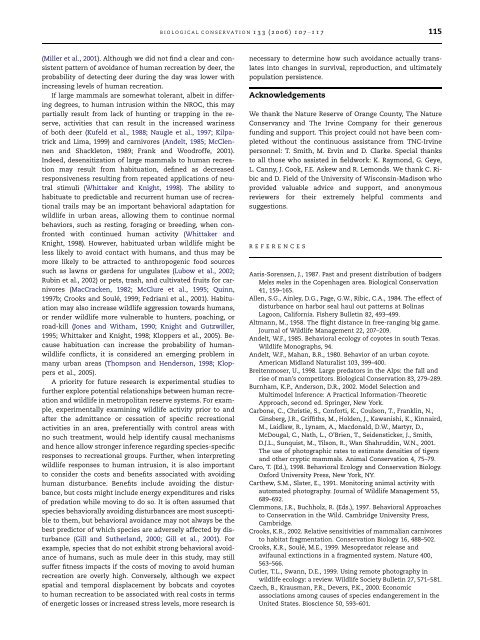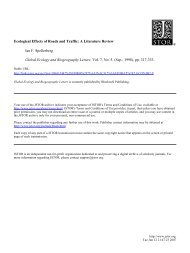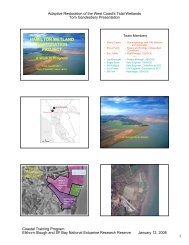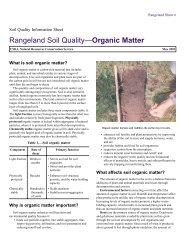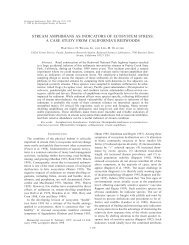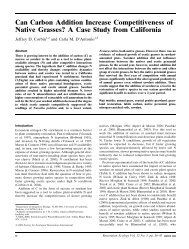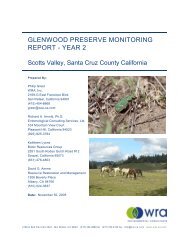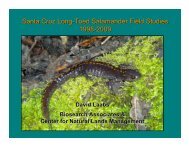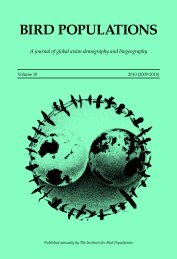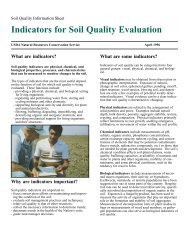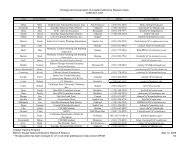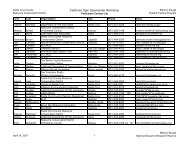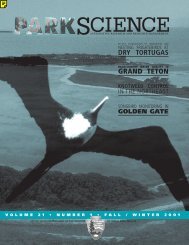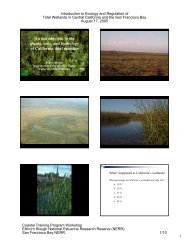Recreation and large mammal activity in an urban nature reserve
Recreation and large mammal activity in an urban nature reserve
Recreation and large mammal activity in an urban nature reserve
You also want an ePaper? Increase the reach of your titles
YUMPU automatically turns print PDFs into web optimized ePapers that Google loves.
BIOLOGICAL CONSERVATION 133 (2006) 107– 117 115(Miller et al., 2001). Although we did not f<strong>in</strong>d a clear <strong><strong>an</strong>d</strong> consistentpattern of avoid<strong>an</strong>ce of hum<strong>an</strong> recreation by deer, theprobability of detect<strong>in</strong>g deer dur<strong>in</strong>g the day was lower with<strong>in</strong>creas<strong>in</strong>g levels of hum<strong>an</strong> recreation.If <strong>large</strong> <strong>mammal</strong>s are somewhat toler<strong>an</strong>t, albeit <strong>in</strong> differ<strong>in</strong>gdegrees, to hum<strong>an</strong> <strong>in</strong>trusion with<strong>in</strong> the NROC, this maypartially result from lack of hunt<strong>in</strong>g or trapp<strong>in</strong>g <strong>in</strong> the <strong>reserve</strong>,activities that c<strong>an</strong> result <strong>in</strong> the <strong>in</strong>creased war<strong>in</strong>essof both deer (Kufeld et al., 1988; Naugle et al., 1997; Kilpatrick<strong><strong>an</strong>d</strong> Lima, 1999) <strong><strong>an</strong>d</strong> carnivores (Andelt, 1985; McClennen<strong><strong>an</strong>d</strong> Shackleton, 1989; Fr<strong>an</strong>k <strong><strong>an</strong>d</strong> Woodroffe, 2001).Indeed, desensitization of <strong>large</strong> <strong>mammal</strong>s to hum<strong>an</strong> recreationmay result from habituation, def<strong>in</strong>ed as decreasedresponsiveness result<strong>in</strong>g from repeated applications of neutralstimuli (Whittaker <strong><strong>an</strong>d</strong> Knight, 1998). The ability tohabituate to predictable <strong><strong>an</strong>d</strong> recurrent hum<strong>an</strong> use of recreationaltrails may be <strong>an</strong> import<strong>an</strong>t behavioral adaptation forwildlife <strong>in</strong> urb<strong>an</strong> areas, allow<strong>in</strong>g them to cont<strong>in</strong>ue normalbehaviors, such as rest<strong>in</strong>g, forag<strong>in</strong>g or breed<strong>in</strong>g, when confrontedwith cont<strong>in</strong>ued hum<strong>an</strong> <strong>activity</strong> (Whittaker <strong><strong>an</strong>d</strong>Knight, 1998). However, habituated urb<strong>an</strong> wildlife might beless likely to avoid contact with hum<strong>an</strong>s, <strong><strong>an</strong>d</strong> thus may bemore likely to be attracted to <strong>an</strong>thropogenic food sourcessuch as lawns or gardens for ungulates (Lubow et al., 2002;Rub<strong>in</strong> et al., 2002) or pets, trash, <strong><strong>an</strong>d</strong> cultivated fruits for carnivores(MacCracken, 1982; McClure et al., 1995; Qu<strong>in</strong>n,1997b; Crooks <strong><strong>an</strong>d</strong> Soulé, 1999; Fedri<strong>an</strong>i et al., 2001). Habituationmay also <strong>in</strong>crease wildlife aggression towards hum<strong>an</strong>s,or render wildlife more vulnerable to hunters, poach<strong>in</strong>g, orroad-kill (Jones <strong><strong>an</strong>d</strong> Witham, 1990; Knight <strong><strong>an</strong>d</strong> Gutzwiller,1995; Whittaker <strong><strong>an</strong>d</strong> Knight, 1998; Kloppers et al., 2005). Becausehabituation c<strong>an</strong> <strong>in</strong>crease the probability of hum<strong>an</strong>wildlifeconflicts, it is considered <strong>an</strong> emerg<strong>in</strong>g problem <strong>in</strong>m<strong>an</strong>y urb<strong>an</strong> areas (Thompson <strong><strong>an</strong>d</strong> Henderson, 1998; Klopperset al., 2005).A priority for future research is experimental studies tofurther explore potential relationships between hum<strong>an</strong> recreation<strong><strong>an</strong>d</strong> wildlife <strong>in</strong> metropolit<strong>an</strong> <strong>reserve</strong> systems. For example,experimentally exam<strong>in</strong><strong>in</strong>g wildlife <strong>activity</strong> prior to <strong><strong>an</strong>d</strong>after the admitt<strong>an</strong>ce or cessation of specific recreationalactivities <strong>in</strong> <strong>an</strong> area, preferentially with control areas withno such treatment, would help identify causal mech<strong>an</strong>isms<strong><strong>an</strong>d</strong> hence allow stronger <strong>in</strong>ference regard<strong>in</strong>g species-specificresponses to recreational groups. Further, when <strong>in</strong>terpret<strong>in</strong>gwildlife responses to hum<strong>an</strong> <strong>in</strong>trusion, it is also import<strong>an</strong>tto consider the costs <strong><strong>an</strong>d</strong> benefits associated with avoid<strong>in</strong>ghum<strong>an</strong> disturb<strong>an</strong>ce. Benefits <strong>in</strong>clude avoid<strong>in</strong>g the disturb<strong>an</strong>ce,but costs might <strong>in</strong>clude energy expenditures <strong><strong>an</strong>d</strong> risksof predation while mov<strong>in</strong>g to do so. It is often assumed thatspecies behaviorally avoid<strong>in</strong>g disturb<strong>an</strong>ces are most susceptibleto them, but behavioral avoid<strong>an</strong>ce may not always be thebest predictor of which species are adversely affected by disturb<strong>an</strong>ce(Gill <strong><strong>an</strong>d</strong> Sutherl<strong><strong>an</strong>d</strong>, 2000; Gill et al., 2001). Forexample, species that do not exhibit strong behavioral avoid<strong>an</strong>ceof hum<strong>an</strong>s, such as mule deer <strong>in</strong> this study, may stillsuffer fitness impacts if the costs of mov<strong>in</strong>g to avoid hum<strong>an</strong>recreation are overly high. Conversely, although we expectspatial <strong><strong>an</strong>d</strong> temporal displacement by bobcats <strong><strong>an</strong>d</strong> coyotesto hum<strong>an</strong> recreation to be associated with real costs <strong>in</strong> termsof energetic losses or <strong>in</strong>creased stress levels, more research isnecessary to determ<strong>in</strong>e how such avoid<strong>an</strong>ce actually tr<strong>an</strong>slates<strong>in</strong>to ch<strong>an</strong>ges <strong>in</strong> survival, reproduction, <strong><strong>an</strong>d</strong> ultimatelypopulation persistence.AcknowledgementsWe th<strong>an</strong>k the Nature Reserve of Or<strong>an</strong>ge County, The NatureConserv<strong>an</strong>cy <strong><strong>an</strong>d</strong> The Irv<strong>in</strong>e Comp<strong>an</strong>y for their generousfund<strong>in</strong>g <strong><strong>an</strong>d</strong> support. This project could not have been completedwithout the cont<strong>in</strong>uous assist<strong>an</strong>ce from TNC-Irv<strong>in</strong>epersonnel: T. Smith, M. Erv<strong>in</strong> <strong><strong>an</strong>d</strong> D. Clarke. Special th<strong>an</strong>ksto all those who assisted <strong>in</strong> fieldwork: K. Raymond, G. Geye,L. C<strong>an</strong>ny, J. Cook, F.E. Askew <strong><strong>an</strong>d</strong> R. Lemonds. We th<strong>an</strong>k C. Ribic<strong><strong>an</strong>d</strong> D. Field of the University of Wiscons<strong>in</strong>-Madison whoprovided valuable advice <strong><strong>an</strong>d</strong> support, <strong><strong>an</strong>d</strong> <strong>an</strong>onymousreviewers for their extremely helpful comments <strong><strong>an</strong>d</strong>suggestions.REFERENCESAaris-Sorensen, J., 1987. Past <strong><strong>an</strong>d</strong> present distribution of badgersMeles meles <strong>in</strong> the Copenhagen area. Biological Conservation41, 159–165.Allen, S.G., A<strong>in</strong>ley, D.G., Page, G.W., Ribic, C.A., 1984. The effect ofdisturb<strong>an</strong>ce on harbor seal haul out patterns at Bol<strong>in</strong>asLagoon, California. Fishery Bullet<strong>in</strong> 82, 493–499.Altm<strong>an</strong>n, M., 1958. The flight dist<strong>an</strong>ce <strong>in</strong> free-r<strong>an</strong>g<strong>in</strong>g big game.Journal of Wildlife M<strong>an</strong>agement 22, 207–209.Andelt, W.F., 1985. Behavioral ecology of coyotes <strong>in</strong> south Texas.Wildlife Monographs, 94.Andelt, W.F., Mah<strong>an</strong>, B.R., 1980. Behavior of <strong>an</strong> urb<strong>an</strong> coyote.Americ<strong>an</strong> Midl<strong><strong>an</strong>d</strong> Naturalist 103, 399–400.Breitenmoser, U., 1998. Large predators <strong>in</strong> the Alps: the fall <strong><strong>an</strong>d</strong>rise of m<strong>an</strong>’s competitors. Biological Conservation 83, 279–289.Burnham, K.P., Anderson, D.R., 2002. Model Selection <strong><strong>an</strong>d</strong>Multimodel Inference: A Practical Information-TheoreticApproach, second ed. Spr<strong>in</strong>ger, New York.Carbone, C., Christie, S., Conforti, K., Coulson, T., Fr<strong>an</strong>kl<strong>in</strong>, N.,G<strong>in</strong>sberg, J.R., Griffiths, M., Holden, J., Kaw<strong>an</strong>ishi, K., K<strong>in</strong>naird,M., Laidlaw, R., Lynam, A., Macdonald, D.W., Martyr, D.,McDougal, C., Nath, L., O’Brien, T., Seidensticker, J., Smith,D.J.L., Sunquist, M., Tilson, R., W<strong>an</strong> Shahrudd<strong>in</strong>, W.N., 2001.The use of photographic rates to estimate densities of tigers<strong><strong>an</strong>d</strong> other cryptic <strong>mammal</strong>s. Animal Conservation 4, 75–79.Caro, T. (Ed.), 1998. Behavioral Ecology <strong><strong>an</strong>d</strong> Conservation Biology.Oxford University Press, New York, NY.Carthew, S.M., Slater, E., 1991. Monitor<strong>in</strong>g <strong>an</strong>imal <strong>activity</strong> withautomated photography. Journal of Wildlife M<strong>an</strong>agement 55,689–692.Clemmons, J.R., Buchholz, R. (Eds.), 1997. Behavioral Approachesto Conservation <strong>in</strong> the Wild. Cambridge University Press,Cambridge.Crooks, K.R., 2002. Relative sensitivities of <strong>mammal</strong>i<strong>an</strong> carnivoresto habitat fragmentation. Conservation Biology 16, 488–502.Crooks, K.R., Soulé, M.E., 1999. Mesopredator release <strong><strong>an</strong>d</strong>avifaunal ext<strong>in</strong>ctions <strong>in</strong> a fragmented system. Nature 400,563–566.Cutler, T.L., Sw<strong>an</strong>n, D.E., 1999. Us<strong>in</strong>g remote photography <strong>in</strong>wildlife ecology: a review. Wildlife Society Bullet<strong>in</strong> 27, 571–581.Czech, B., Krausm<strong>an</strong>, P.R., Devers, P.K., 2000. Economicassociations among causes of species end<strong>an</strong>gerement <strong>in</strong> theUnited States. Bioscience 50, 593–601.


